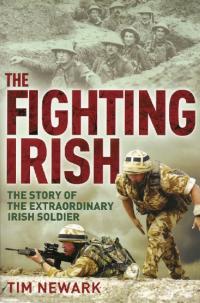The fighting Irish: the story of the extraordinary Irish soldier
Published in Book Reviews, Issue 6 (Nov/Dec 2012), Reviews, Volume 20
The fighting Irish: the story of the extraordinary Irish soldier
Tim Newark
(Constable & Robinson, €16.99)
ISBN 9781849015158
The history of the Irish soldier remains a subject of fascination for both scholars and general readers alike. Recent years have seen a steady growth in the literature on this subject, while the National Museum of Ireland’s ‘Soldiers and Chiefs’ exhibition remains hugely popular. For centuries successive generations of Irishmen have served in foreign armies, and it is no exaggeration to state that Irish soldiers have served in every major conflict since 1685. Since that date it is possible to identify Irish soldiers and regiments in the armies of France, Spain, Austria, Russia and the United States, among others. Ireland was also traditionally a fruitful recruiting ground for the British army, a process that was facilitated by the lifting of the ban on the recruitment of Catholic soldiers under the terms of the Relief Act of 1793. Within the wider narrative of this Irish military phenomenon there were further historical subtexts, as each wave of enlistments and military migration reflected political, social and economic factors within Ireland. For those who served abroad, military service was often their first step towards acceptance and respectability in their adoptive country. The modern Irish defence forces have maintained a proud record of service with the United Nations, while Irish soldiers are still a feature of armies outside of Ireland.
This is a vast subject and there have been previous attempts to address it. A military history of Ireland edited by Thomas Bartlett and Keith Jeffrey (1996) remains a seminal text, while A.E.C. Bredin’s A history of the Irish soldier (1987) addresses the subject in a more popular format. Newark’s The fighting Irish: the story of the extraordinary Irish soldier attempts to examine the topic in a manner obviously designed for a popular audience. The remit of this book is extremely extensive and he deals with Irish military service from the late seventeenth century to the present day. In order to do this he frequently refers to individual stories to illustrate the experiences of Irish soldiers through history. Chapters are devoted to the Wild Geese, the Irish in the Napoleonic Wars and the two world wars, with later chapters on subjects such as the Congo and Irish soldiers serving in the ‘war on terror’. It is written in an entertaining style and includes some interesting illustrations, indexes of medal-winners and some hints for further reading.
From a historical perspective, however, this book should be approached with some caution. Newark has attempted to examine the Irish military phenomenon in its entirety, and an incautious or ill-informed reader would be forgiven for believing that a level of continuity existed between the successive phases of Irish military service. There is simply not enough attention given to examining the specific contexts of the Wild Geese, for example, or the Irish soldiers who served in the Union army during the American Civil War. There seems to be an implicit suggestion here of a level of continuity in the motivations of various generations of Irish soldiers. This simply did not exist.
A second point, and perhaps related to the above, is the selective way in which case-studies are chosen and treated. It was not uncommon for Irish soldiers to show up on both sides in conflicts throughout history and this aspect is not treated in enough depth. In cases where it is mentioned, such as in references to the second Anglo-Boer War and the Spanish Civil War, the contradictory motivations that prompted Irishmen to serve on opposite sides are not dealt with in detail. For example, a chapter entitled ‘The Emerald Flag’ is devoted to the Irish in the American Civil War, concentrating on the Irish in the Union army. Newark makes the statement that ‘many Irish fought for the Confederates and some of them were at the Battle of Fredericksburg’. He neglects to mention that over 20,000 Irish fought for the Confederacy, perhaps owing to the fact that this would require a level of complex contextual explanation, while it might also cast doubt on some other later statements in the book.
The selective and somewhat simplistic tone is perhaps summed up in its last lines: ‘Together, American-Irish, British-Irish and Irish from the Republic of Ireland continue to fight for freedom around the world’. This reflects an almost complete ignorance of the complex motivations behind the enlistment of generations of Irish soldiers. For example, it is unlikely that an Irish soldier joining an Irish regiment in the British army in the nineteenth century considered himself to be doing so to ‘fight for freedom’. To take another one of Newark’s own case-studies, for whose freedom was Captain Myles Walter Keogh fighting when he was killed at the Battle of the Little Big Horn in 1876? Was it for the freedom of white settlers and prospectors to take Sioux and Cheyenne land? Towards the end of the book Newark also refers to the recent campaigns in Afghanistan and Iraq, and it is perhaps in this context that the ‘for freedom’ argument seems most jarring. Only the most ill-informed or naive reader could possibly ascribe such heroic ideals to these recent campaigns.
While no doubt designed to entertain rather than to inform, this book represents a simplistic treatment of an extremely complex subject. Any reader needs to give serious attention to the wider contextual factors that are simply not dealt with adequately here. This book falls into a wider and growing category of literature that attaches heroic values and motivations to soldiers throughout history, without qualification. Such a message is questionable from the historical viewpoint, and this is especially true in light of the morally dubious nature of recent campaigns. HI
David Murphy lectures in history at NUI Maynooth.
















